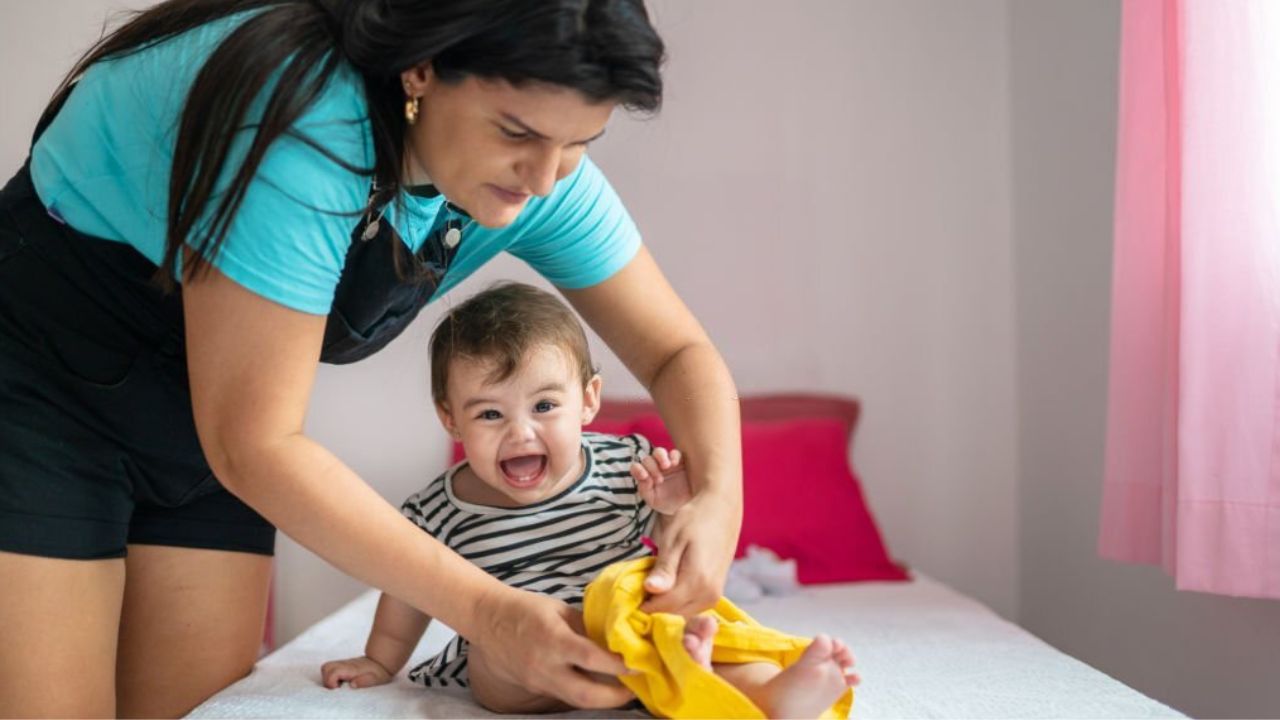
The journey of parenthood is filled with many responsibilities. One of the first tasks is understanding the nuances of dressing your newborn. With the right knowledge and a touch of care, this task can be both rewarding and enjoyable.
How To Dress A Newborn
 Choose soft, breathable fabrics:
Choose soft, breathable fabrics:
Newborns have delicate skin that is easily irritated, so it's important to choose clothes made of soft, breathable fabrics like cotton baby bodysuits. Avoid synthetic fabrics, which can trap heat and moisture and cause skin irritation.
Dress your baby in layers:
Layering is a great way to keep your baby warm and comfortable in cold weather. Start with a onesie or cute and comfy baby tops, add a long-sleeved shirt or sweater, and finish with a warm jacket or coat. Make sure the layers are not too bulky and that your baby can move their arms and legs freely.
Keep your baby's head covered:
Newborns lose heat quickly through their heads, so it's important to keep their head covered with a hat or cap, especially in cold weather.
Use mittens or socks to keep your baby's hands warm:
Newborns have poor circulation and can easily get cold hands and feet. Use mittens or socks to keep your baby's hands warm, but make sure they are not too tight and that your baby can move their fingers freely.
Avoid clothes with buttons, zippers, or ties:
Clothes with buttons, zippers, or ties can be uncomfortable for newborns and can also pose a choking hazard. Choose clothes with snaps or elastic instead.
Dress your baby in clothes that are easy to put on and take off:
Newborns need frequent diaper changes, so it's important to choose clothes that are easy to put on and take off. Look for clothes with snaps or zippers that open from the front or back.
Check your baby's temperature regularly:
Newborns can't regulate their body temperature as well as adults, so it's important to check your baby's temperature regularly to make sure they are not too hot or too cold. Feel your baby's chest or back to check for warmth, and adjust their clothing as needed.
Preparing a Newborn for Cold Climates
When the temperature drops, layering is essential. But it's equally important not to overdo it. A warm onesie, combined with a hat, mittens, and a soft blanket, usually suffices. If you feel comfortable in the room, your baby likely does too.
Onesies: How Many Are Enough?
A frequently asked question revolves around the number of onesies a newborn might need. Having 7-10 onesies is a safe bet, given the regular changes they'll undergo in the early stages, ensuring there's always a clean one available.
How To Dress A Newborn For Sleep?

Dressing a newborn for sleep is essential for their safety and comfort. Here are some guidelines to ensure your baby sleeps safely and comfortably:
Layering:
Choose a single one-piece sleep sustainable outfits that's appropriate for the room temperature. Avoid overdressing; instead, layer the baby with a wearable blanket or sleep sack if more warmth is needed.
Avoid Loose Clothing:
Ensure the clothing fits snugly to prevent any loose fabric from covering the baby's face, which could pose a suffocation risk.
Skip Accessories:
Avoid hats, bows, or any other accessories that might come off and become a choking hazard during sleep. Also, avoid outfits with strings or ties.
Opt for Footed Sleepers:
These provide warmth without the need for socks, which could come off and become lost in the crib.
Soft, Breathable Fabric:
Choose soft, breathable fabrics like cotton to prevent overheating and to keep the baby comfortable throughout the night.
Avoid Embellishments:
It's best to select sleepwear without any buttons, beads, or other small parts that could be a choking hazard if they come off. Also, avoid clothing with rough seams or tags that might irritate the baby's skin.
Check the Temperature:
The ideal room temperature for a baby's sleep is between 68-72°F (20-22°C). Adjust the baby's clothing based on the room's temperature. If the room is cooler, you might add a layer, but if it's warmer, a single layer should suffice. To check if your baby is warm enough, feel the back of their neck; it should be warm, not sweaty or cold.
Use Wearable Blankets or Sleep Sacks:
Instead of loose blankets, which pose a suffocation risk, use a wearable blanket or sleep sack to keep your baby warm.
Ensure Flat Sleep Surface:
Always place your newborn on their back on a firm, flat surface like a mattress in a safety-approved crib or bassinet without pillows, quilts, or toys.
Zippers and Snaps:
Choose outfits with zippers or snaps that run from top to bottom, making nighttime diaper changes easier.
What type of fabric is best for a newborn's clothes?
Cotton:
This is one of the most popular choices for newborn clothing. It's soft, breathable, and gentle on a baby's delicate skin. Organic cotton is an even better choice as it's grown without the use of harmful pesticides or chemicals.
Muslin:
This lightweight, breathable cotton fabric is great for swaddle blankets and light clothing, especially in warmer climates. It becomes softer with each wash.
Bamboo:
Bamboo fabric is soft, breathable, and has natural antibacterial properties. It's also known for its temperature-regulating qualities, keeping the baby warm in cool weather and cool in warm weather.
Modal:
Derived from the pulp of beech trees, modal is soft, stretchy, and retains its shape well. It's also known for its moisture-wicking properties, making it comfortable for babies.
Merino Wool:
While it might sound a bit unconventional for newborns, fine merino wool is excellent for stylish baby rompers, especially in colder climates. It's soft, natural, breathable, and has temperature-regulating properties. It also naturally resists odor and is fire-resistant.
Fleece (for outer layers):
For colder weather, fleece can be an excellent choice for outer layers, such as jackets or booties. It's warm and lightweight, but it should always be used as an external layer rather than against the baby's skin.
Things to Avoid
- Synthetic Fabrics: Fabrics like polyester can be less breathable and might retain heat, potentially causing the baby to overheat. They can also be more likely to irritate a baby's sensitive skin.
- Rough Seams and Tags: These can cause irritation to the baby's skin. Opt for clothes with flat seams and tag less designs or remove tags if they seem bothersome.
- Tight Elastics: Any clothing with tight elastics can be uncomfortable and restrictive for a newborn.
Also check my guide on stain removable tips for dirty baby clothes
Final Note
In wrapping up, the nuances of dressing a newborn go beyond just picking cute outfits. It's about understanding the delicate nature of their skin, the fluctuating room temperatures, and the importance of sustainable choices.
Every onesie or piece of clothing you pick plays a direct role in your baby's comfort and health. Being informed and conscious in these early decisions sets a foundation for mindful parenting in the years to come.
